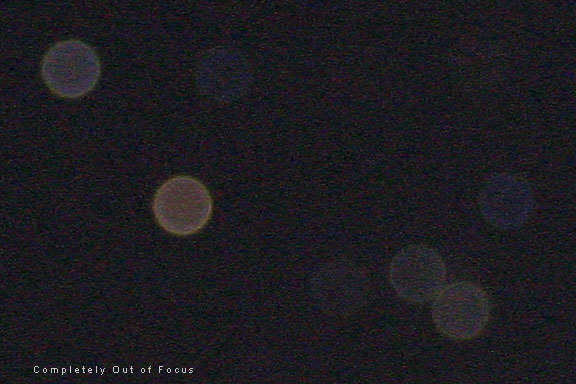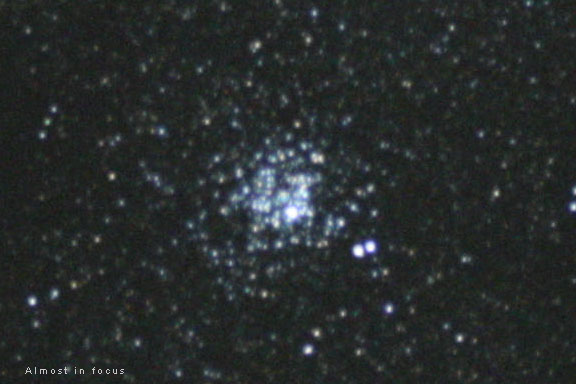Mouse-Over

|
|
Hold your mouse cursor over the image to see a comparison between a photo that is completely out of focus, and one that is in focus. It is easy to tell when an image is completely out of focus.
|
Accurate focus is critical for high-quality astrophotography. But before the arrival of Live View focusing, it was surprisingly hard for most amateur astrophotographers to focus a camera lens or telescope.
Just looking through the viewfinder is usually not a very good method of focusing. Viewfinder on DSLRs are fairly dim. The eyepiece is often pointed at the ground when the scope is pointed overhead and can be very inconvenient to look through and use. The eye's ability to accommodate can also make focusing problematic. Camera lenses, particularly wide-angle models, give very low magnification and most now focus past infinity, making focusing very difficult visually through the viewfinder.
With the tremendous amount of time and effort invested in long-exposure deep-sky astrophotography, it is a shame for the pictures to be ruined by poor focus. But with Live View focus, and the use of Bahtinov masks on DSLRs without Live View, it is pretty easy to focus your camera lens or to focus your telescope for astrophotography these days.
The stars we see in the night sky are really point sources because they are so far away. We can see them because they are too bright to be ignored. But when their light passes through an aperture, the light is affected by diffraction effects because of the quantum nature of light. A true point source like a star will actually form a small disk, called the diffraction disk, at the focal plane.
The linear size of the diffraction disk is dependent only on the focal ratio of the telescope. Faster optical systems form stars with smaller diffraction disks. The faintness of a star that can be recorded in a given exposure is dependent only on the aperture of the telescope.
For any given focal ratio, there is a small range of focus where the diffraction disk stays as small as possible. This range is called the depth of focus. The depth of focus is smaller for fast optical systems that can form a very small diffraction disk.
For example, a perfect f/1.4 lens can form an Airy disk that is 2.2 microns in diameter. A micron is one millionth of a meter, or one thousandth of a millimeter, or 0.000039 inches. For comparison, a human hair is about 100 microns. The depth of focus for this 50mm f/1.4 lens at f/1.4 is 6.2 microns.
An f/8 lens can form an Airy disk that is about 12 microns in diameter, and the depth of focus is about 200 microns. As we can see, even at f/8, focusing is very critical.
Note that depth of focus is different from depth of field. Depth of field describes the range of focus that appears sharp in a photograph for subject planes in a terrestrial scene at distances less than infinity for a given lens at a particular focal ratio. Depth of focus describes focus at the focal plane in the camera. Depth of field describes focus at the subject in the real world.
Mouse-Over

|
|
Hold your mouse cursor over the image to see a comparison between a photo that is almost in focus, and one that is in focus. When you get closer to focus, it is harder to tell if the image is exactly focused. If focus is a little bit off, it can lead to blurriness and larger star sizes, and loss of fainter stars. This is open cluster M11, the Wild Duck Cluster. It was shot with a Canon EOS 1000D (Digital Rebel XS) DSLR camera and a Stellarvue SV70ED doublet refractor.
|
Focusing Problems and Solutions
- My images are not in focus!
- Reason - The camera's sensor is not coincident with the focal plane of the scope or camera lens.
- Solution:
- Use Live View focus on a bright star and focus in real time.
- If you don't have a camera with Live View focus, use a Bahtinov mask and trial and error and examine test images at high magnification on the LCD on the back of the camera.
- Stars in the corner of the field are out of focus when I focus on a star in the center of the field.
- Reason - The focal plane on most telescopes is curved.
- Solution: Use a field flattener.
- Stars in the corners of the field look like comets.
- Reason - This is from coma and is often found in fast Newtonians.
- Solution: Use a coma corrector.
- My Newtonian scope can't reach focus at all with my DSLR camera.
- Reason - Many Newtonians are designed to be visual instruments and a camera's sensor sits farther back in the focuser than an eyepiece.
- Solution: Move the mirror up in the tube, use a lower profile focuser.
- Focus changes during the night.
- Reason - The focus will change as the telescope tube contracts or expands as the temperature changes. Temperatures usually fall during the night, so focus will definitely change. This problem is made worse in SCT's due to the secondary magnification which greatly magnifies this effect.
- Solution: Monitor the temperature, and refocus periodically through the night.
- The mirror shifts in my Schmidt-Cassegrain when I try to focus.
- Reason - Schmidt Cassegrain telescopes focus by moving the entire primary mirror assembly, and the image can shift significantly when the direction of movement of the focus knob is changed.
- Solution: This can be overcome by always coming to focus from the same direction, or by locking down the primary mirror and installing a third-party external focuser.
- I focus with an eyepiece and put in the camera, but the image is out of focus.
- Reason - The camera does not focus in the same location as an eyepiece. Many different eyepieces even focus in different locations.
- Solution: You have to focus through the camera itself or with Live View focus.
- It is hard to focus during bad seeing.
- Reason - Bad seeing will affect star sizes in the final image and make the focus seem worse. Bad seeing can also make the actual process of focusing more difficult.
- Solution: Wait for a period of better seeing. You can also use software-assisted metric focusing where a series of exposures are taken over time and resulting values are averaged. This can be time-consuming however.
- It's hard to see through the viewfinder or use the LCD on the back of the camera with Live View focus when the scope is pointed overhead.
- Reason - The camera's viewfinder's eyepiece is located at an awkward position.
- Solution: Focus on a star that is about 20 to 30 degrees above the horizon where it is more convenient to see the LCD on the back of the camera. Then lock down the focus and move the scope back to the target.
- I can't see anything with Live View when I try to focus.
- Reason - Live View is really made for daytime use. It won't detect faint stars. If the star is grossly out of focus, it is too dim to be detected.
- Solution:
- Live View will only work with bright stars. Use the brightest star or planet you can find.
- Live View tries to simulate the brightness of the exposure you are using, so be sure to set the camera to ISO 1600 and use the Bulb setting for long exposures for focusing on stars.
- Live View will only show stars that are somewhat close to focus. If a star is too far out of focus, its light will be spread out in a much larger area (see the example at the top of the page), and it will be too dim to see on Live View. So pre-focus the scope or lens visually to get close before you try to use Live View.
|
Problem: Poor Focus - The Bottom Line
Accurate focus is critical for astrophotography and is harder than you would imagine at first.
The latest cameras with Live View make focusing easy. Older cameras can be focused by test exposures with a Bahtinov mask.
|